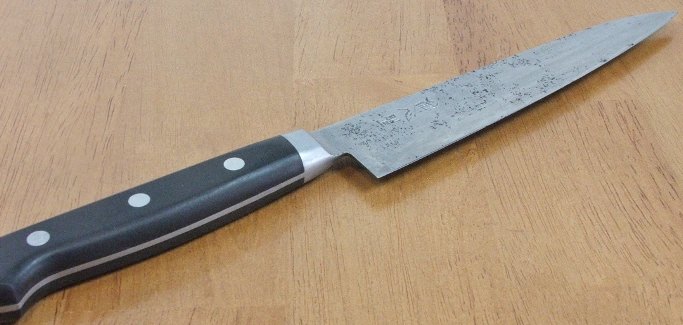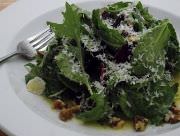Professional Kitchen Knives
 Wusthof Chef's Knife.
Wusthof Chef's Knife.Elements Of Steel Used In Professional Kitchen Knives
Professional kitchen knives are an essential requirement. Some things to consider are edge design, blade shape and handle construction. However the most distinctive element, of your kitchen knives, is the steel used to make it.
To maintain the edge of your knives check out my page about knife sharpening techniques.
Carbon Steel
Carbon steel knives are made from iron combined with Carbon. Carbon is necessary as iron can't be tempered without it. Although carbon increases steel’s hardness, it reduces rust resistance, and makes steel more fragile.
 Carbon Steel Utility Knife
Carbon Steel Utility KnifeThe Benefits Of Carbon Steel Knives
A good quality carbon steel knife will attain a near razor sharp edge quickly and easily. Once sharpened they will hold their edge fairly well.
Their near razor sharpness makes them ideal for breaking down fish with thick skin, such as tuna or butchering meat.
The Disadvantages Of Carbon Steel
They don't hold an edge as well as hardened steel knives because the metal isn't as hard.
They are highly susceptible to rusting and as such should not be left sitting in water.
They will discolor and turn black if they come into contact with acidic foods, such as tomatoes, citrus fruits, and vinegar. In the image below you can see the pitting that the blade has developed over time due to contact with acidic foods.
 Carbon steel knife showing pitting of the blade.
Carbon steel knife showing pitting of the blade.Stain Resistant Steel Or Hardened Steel
Adding chromium-oxide to the mixture of iron and carbon produces the stain resistant steel commonly used in Japanese kitchen knives. A film forms on the surface that prevents the iron from coming into contact with oxygen and water.
 Misono 440 Chef's Knife
Misono 440 Chef's KnifeThe Benefits Of Hardened Steel
Once properly sharpened
they will maintain their edge well. If you run them across a steel to
true the edge each time you use them you shouldn't need to put them on a
stone for quite some time.
The weight of a good quality hardened steel knife allows it to be used when going through bone or frozen foods. The flexibility of the blade makes it ideal for boning meat and cleaning fish.
The Disadvantages Of Hardened Steel
The hardness of the steel makes them difficult to sharpen properly, which means that for many people they will require professional sharpening.
Ceramic Kitchen Knives
 Ceramic Kitchen Knives: Chef'S Knife, Cheese Knife, And Paring Knife
Ceramic Kitchen Knives: Chef'S Knife, Cheese Knife, And Paring Knife
In a home kitchen ceramic knives can be very useful, because they hold their edge for a very long time, without needing to sharpen them. This makes ceramic knives a good choice for your kitchen knives. Just don't drop them. Ceramic is very brittle and can shatter if dropped.
The Benefits Of Ceramic Knives
They hold an edge that is very sharp, this is due to the hardness of the blade. Ceramic has a hardness that is greater than hardened steel. Because of their hardness they will not pick up and transfer odors from one food to another. A simple rinse under running water and you are ready to cut something else.
The density of the ceramic keeps them more sanitary than a metal knife. Because they are made of ceramic they are lightweight and they will not rust. They excel at slicing and in that arena they can out perform steel knives.
The Disadvantages Of Ceramic Knives
They are very brittle and can chip if you try and go through bone or frozen food. They blades are not flexible and therefore, not as versatile as a steel knife.
For most people when they do need to be sharpened you must send them back to the manufacturer to be sharpened, which most manufacturers will do for free. However you are without your knife during that period. If you are experienced with sharpening your own knives you can use a diamond steel to sharpen your ceramic knives.
The Essential Kitchen Knives
While there are a variety of kitchen knives available chef's, bread, cleavers, paring, turning, utility, slicers, and others - you truly only need four. That's right with four knives you can accomplish every job you need to do in a kitchen.
When choosing knives for your kitchen buy the best you can afford. Since you only need four that shouldn't break the bank. I highly recommend Professional knives. They are crafted with carbon or hardened steel and will provide you with years of service as long as you take care of them.
 Professional kitchen knives: bread knife, chef's knife, utility knife, and a paring knife.
Professional kitchen knives: bread knife, chef's knife, utility knife, and a paring knife.
Chefs Knife
Typically these are six, eight, or ten inch in length. The blade tapers to a point, they have a sturdy heel, and are typically heavy.
Utility Knife
These come in a variety of lengths and are characterized by their flexible blade which makes them excellent for boning or butchering fish.
Bread Knife
These typically come in 2 styles in-line or offset, and have a serrated edge making them ideal for sawing through bread.
Paring Knife
These are used for fine or detail work.
That's it, four knives and you will be able to do everything you will need to do in your kitchen.
A few final words about knives, if it cost less than 30.00 it is probably not worth the metal it is stamped from. You don’t have to buy 200 or 300 dollar knives but you do need good ones. When choosing your kitchen knives there really isn't a "best knife". It all comes down to your personal preference and that is based on how a given knife feels in your hand, and, of course, your budget.
For more about kitchen knives you can check out the following pages.




